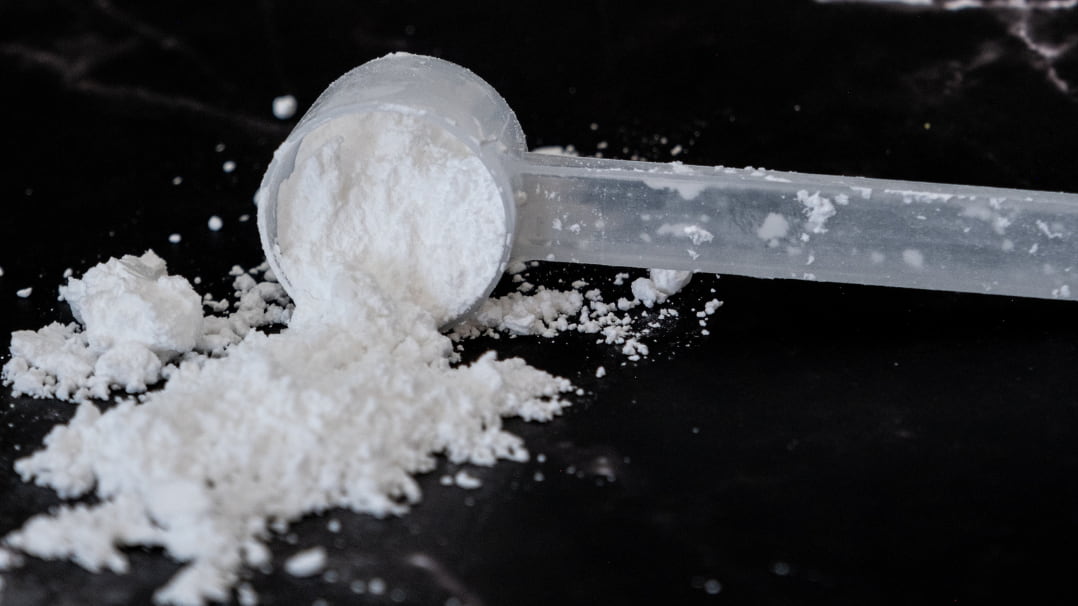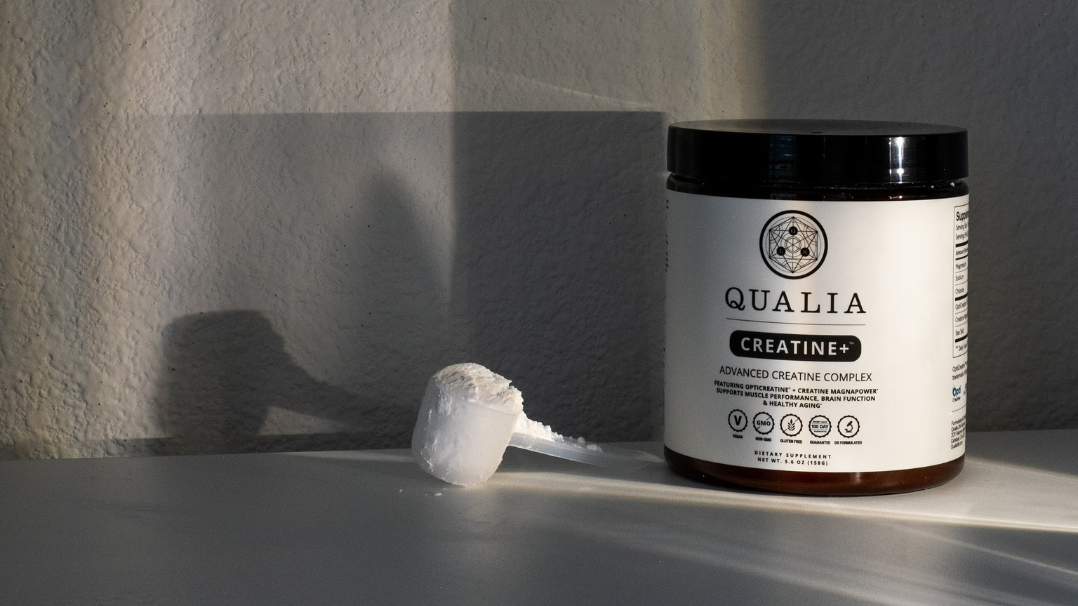Key Learning Objectives
- Understand how fatty acid metabolism contributes to ATP production
- Discover ketone bodies and their metabolic function
- Learn how fatty acid oxidation is associated with the aging process
- Discover how fatty acid metabolism can be supported
What Is Fatty Acid Oxidation?
Fatty acids are an important fuel for the generation of cell energy in the form of adenosine triphosphate (ATP). Fatty acid oxidation, also known as beta-oxidation, is the metabolic pathway of fatty acid breakdown for energy production. It consists of the sequential oxidation (i.e., loss of electrons) and cleavage of the fatty acid hydrocarbon chain to yield acetyl-CoA that can then be used in the citric acid cycle for further oxidation and ATP production[1,2].
Fatty acids are actually the primary source of energy for some tissues, most notably the heart (i.e., the cardiac muscle) and skeletal muscle during rest or moderate physical activity.
Before we dive into the details of fatty acid metabolism, we’ll review some terms and concepts you may have heard about and that will help us understand fatty acid oxidation and its role in cellular metabolism.
Fatty Acids Are The Fuel For Fatty Acid Oxidation But What Is A Fatty Acid?
Saturated, monounsaturated, polyunsaturated, omega-3’s, trans fats—these are some of the common terms used when the topic of dietary fats comes up. We’ll start by quickly defining these terms because some of the characteristics of fatty acids will influence their metabolic fate.
Fatty acids are the simpler units of dietary fats—also called lipids. There are many different fatty acids, but all have a similar general structure. At one end is the carboxylic acid (COOH)—the group made up of carbon (C), oxygen (O), and a hydrogen (H) bound to an oxygen (OH; called a hydroxyl group)—that makes them acids. Attached to this is a chain of C and H atoms; this is called an aliphatic chain or tail [1,2].
Fatty acids can have different lengths, have even or odd numbers of carbons, be branched or unbranched, and be saturated or unsaturated. These different characteristics will impact where and how a fatty acid is used and metabolized. Most naturally occurring fatty acids are unbranched, and even-numbered varying in length from four to twenty-eight C atoms.
The number of carbon atoms determines whether a fatty acid is categorized as being a short- (SCFA), medium- (MCFA), long- (LCFA), or very long-chain fatty acid (VLCFA). SCFA, such as butyric acid, contain five or fewer carbon atoms. MCFA, which include caprylic, capric, and lauric acid, have six to twelve carbons. Oleic acid and eicosapentaenoic acid (EPA) are examples of LCFA—the group of fatty acids with thirteen to twenty-one carbons. VLCFA are fatty acids with at least 22 carbons; docosahexaenoic acid (DHA) is an example of a VLCFA.
A fatty acid can be saturated, meaning that all its carbons are linked by single bonds (i.e., it has the maximum number of hydrogens bonded to the carbons, and therefore is said to be “saturated” with hydrogen atoms), or it can be unsaturated, meaning that at least two carbons are linked by a double bond. Monounsaturated fatty acids have one double bond and polyunsaturated fatty acids have more than one double bond in the chain. Double bonds in unsaturated fatty acids can have either a cis configuration, with hydrogen atoms on the same side of the carbon chain, or a trans configuration, with hydrogen atoms on opposite sides of the chain. The cis or trans configuration changes the shape of the fatty acid, which will ultimately influence its physiological properties. Most naturally occurring fatty acids will have all double bonds in a cis configuration. The majority of trans fatty acids in the diet are man-made.
The location of the double bonds in unsaturated fats leads to the way they are most often described in nutritional literature (e.g., omega-3’s, omega-6’s). The Greek alphabet is used to number all C after the carboxylic acid, so the first C following it is labeled as α (alpha). No matter how long the chain is, the final C will be labeled using the last letter in the Greek alphabet, ω (omega). In unsaturated fatty acids, starting with this omega C and counting the number of C before you get to a double bond, gives the omega number. So an omega-3 fatty acid means there are 3 carbons at the omega end before you’d arrive at a double bond. An omega-6 means there would be 6 C atoms before the first double bond.
What Are Triglycerides And How Are They Used For Fatty Acid Oxidation?
Dietary lipids are ingested mainly as triglycerides, which are molecules built from three fatty acids attached to a glycerol molecule (and therefore also known as triacylglycerols). Triglycerides are also the form in which fatty acids are stored in adipose tissue, from where they can be mobilized when they are needed for cell energy generation.
Adipose tissue is what we commonly call body fat. It is present throughout our body, most prominently under the skin (the subcutaneous fat) and around our internal organs (the visceral fat). Triglycerides are our body’s major energy reservoir. Each gram of fat yields over 2-fold more energy than each gram of carbohydrates or proteins[1,2].
Fatty acids are the primary source of energy for the heart and for skeletal muscle during rest or moderate physical activity. Triglycerides are our body’s major energy reservoir.
Following ingestion, triglycerides are broken down in the gastrointestinal tract into free fatty acids, the form in which they are absorbed. The fate of the fatty acids will then depend on the length of their carbon chain. SCFAs and MCFAs are absorbed from the gut into the blood flow as free fatty acids and transported to the liver where they are quickly metabolized; they are not stored in adipose tissue.
LCFAs and VLCFAs, on the other hand, are converted back into triglycerides in intestinal absorptive cells (called enterocytes), incorporated into small lipoprotein particles (called chylomicrons), and then transported by the lymphatic system to adipose tissue, cardiac muscle, and skeletal muscles. There, triglycerides in chylomicrons are broken down, releasing the fatty acids for absorption by those tissues, where they can be used for energy production or converted once again into triglycerides for storage.[3]
What Is Lipolysis? Mobilizing Stored Fats Is The First Step In Using Them For Fatty Acid Oxidation
In circumstances such as fasting or exercise, fatty acids are mobilized from triglyceride stores in a process known as lipolysis. During lipolysis, each triglyceride (triacylglycerol) molecule is broken down by sequentially removing fatty acids from the glycerol, yielding diacylglycerol (i.e., glycerol with two fatty acids attached), monoacylglycerol (i.e., glycerol with one fatty acid attached), and finally free glycerol, along with the three free fatty acids.
The free fatty acids and glycerol are then released into the blood and transported to the tissues that need fuel. Glycerol is taken up by the liver and converted into glyceraldehyde 3-phosphate, which can be metabolized in glycolysis. Fatty acids are taken up by cells to be metabolized through fatty acid oxidation. But for that to happen, fatty acids have to reach the cellular structures where fatty acid oxidation takes place: mitochondria.
What Nutrients Are Needed For Longer Chain Fatty Acids To Get Inside Mitochondria Where Fatty Acid Oxidation Occurs?
Fatty acid oxidation takes place in the mitochondrial matrix, the inner compartment of mitochondria. But mitochondria have two membranes that fatty acids have to cross before they reach the matrix. This is another process in which the length of the carbon chain makes a difference.
SCFAs and MCFAs (at least those with up to 8 Cs) are taken up by mitochondria without the need for a special transport system. Once inside, they are activated by binding to coenzyme A (CoA, derived from pantothenic acid / vitamin B5), creating what is called a fatty acyl-CoA.
LCFA and VLCFA, on the other hand, cannot readily cross the mitochondrial membranes and need a mechanism to get them into mitochondria [1,2]. This mechanism is a shuttle that uses carnitine to transport fatty acids and that is thus called the carnitine shuttle. In this shuttle, the fatty acid is first bound to CoA in the cytosol, forming fatty acyl-CoA, and then transferred from CoA to the carnitine molecule, forming acylcarnitine, which is able to cross the mitochondrial membranes through a transporter. Once on the matrix side of the membrane, the fatty acid is transferred back from carnitine to CoA and free carnitine returns to the cytosol through the transporter. Because it is required for the transport of longer chain fatty acids into mitochondria, carnitine has a key role in fatty acid metabolism [1,2]. Qualia Life (previously called Eternus) supports these reactions by supplying Pantothenic Acid (Vitamin B5) [4] and L-Carnitine [5].
Long-chain fatty acids are transported by the carnitine shuttle into the mitochondrial matrix, where their oxidation takes place.
What Nutrients Are Needed For Fatty Acid Oxidation?
Fatty acid oxidation is slightly different depending on whether fatty acids are even or odd numbered and saturated or unsaturated. Saturated fatty acids with even numbers of carbon atoms have the simplest process of beta-oxidation [1,2]: each fatty acid bound to CoA (fatty acyl-CoA) is broken down in a repeated sequence of four reactions: 1) oxidation by FAD+ (flavin adenine dinucleotide, derived from riboflavin / vitamin B2), 2) hydration, 3) oxidation by NAD+ (nicotinamide adenine dinucleotide, derived from niacin / vitamin B3), and 4) cleavage and transfer of a two-carbon unit to CoA (derived from pantothenic acid / vitamin B5) to form acetyl-CoA.
Therefore, in each four-reaction cycle, the fatty acid chain is shortened by two carbons, yielding FADH2, NADH, and acetyl-CoA. You’ll recall that carbons following the carboxylic acid are numbered using the Greek alphabet (alpha, beta, …omega). This process is called beta-oxidation because the oxidation occurs at the beta carbon.
The shortened fatty acyl-CoA molecule can then undergo a new round of beta-oxidation. This continues until the final cleavage of a four-carbon unit into two acetyl-CoA molecules. So, for example, the saturated fatty acid stearic acid, which has 18 carbons, will go through 8 cycles of oxidation to yield 8 FADH2, 8 NADH, and 9 acetyl-CoA. With each cycle, the chain decreases in length by 2 carbons.
The oxidation of unsaturated fatty acids requires additional enzymes to circumvent the existence of double bonds, but the rest of the process is the same. The oxidation of fatty acids with odd numbers of carbon atoms (which are not very common) is similar to the oxidation of even-numbered fatty acids except that instead of generating two acetyl-CoA molecules in the last round, one acetyl-CoA and a three-carbon unit—propionyl-CoA—are formed. Like acetyl-CoA, propionyl-CoA will be further oxidized in the citric acid cycle, but instead of entering it directly, it has to be converted into the citric acid cycle intermediate succinyl-CoA in a reaction that requires biotin (vitamin B7), cobalamin (vitamin B12), and ATP [1,2].
Qualia Life supports fatty acid oxidation by supplying Riboflavin (Vitamin B2) [6], Niacinamide + Nicotinic acid (Vitamin B3) [7], Pantothenic acid (Vitamin B5) [4], Biotin (Vitamin B7) [1], and Vitamin B12 as Methylcobalamin and Adenosylcobalamin [8].
Beta-oxidation cleaves long fatty acids into acetyl-CoA units in a repeated sequence of reactions that yields FADH2 and NADH.
NAD+ and FAD+ are redox molecules that carry electrons to the mitochondrial electron transport chain where ATP is produced. As we’ve seen, in each round of fatty acid oxidation, one molecule of NAD+ and one molecule of FAD+ are reduced to NADH and FADH2, respectively. The acetyl-CoA units produced in fatty acid oxidation will then enter the citric acid cycle, where their oxidation will yield additional NADH and FADH2 [1,2].
Qualia Life supports the activity of NAD and FAD by supplying Niacinamide/Nicotinic acid (Vitamin B3) [7], Vitamin B6 as Pyridoxal-5’-Phosphate (cofactor in the synthesis of NAD+ [9]), L-Tryptophan (substrate for NAD+ synthesis [9]), and Riboflavin (Vitamin B2) [6]. Qualia Life also contains a set of ingredients that support the upregulation of the NAD+ pool in cells. These include Grape Proanthocyanidins (from BioVin® French Red Grapes Extract) [10], Resveratrol (from BioVin® French Red Grapes Extract) [11–13], Coenzyme Q10 (Ubiquinone) [14], and Lipoic Acid [15,16].
NADH and FADH2 are electron carriers that transport the electrons extracted from fatty acids to the electron transport chain to generate ATP.
How Does Fatty Acid Oxidation Interact with Ketones?
Acetyl-CoA produced in fatty acid oxidation enters the citric acid cycle only if fatty acid and glucose degradation are adequately balanced. The reason is that the entry of acetyl-CoA depends on the availability of the citric acid intermediate oxaloacetate, which is the molecule with which acetyl-CoA reacts to enter the citric acid cycle. Oxaloacetate availability, in turn, depends on the rate of glycolysis because it is produced from pyruvate (among other sources), as the final product of glycolysis [1,2].
So, when glucose levels are low, as occurs after a long period of fasting, oxaloacetate levels decrease because it is used to regenerate glucose, via pyruvate, through a pathway called gluconeogenesis. And because less oxaloacetate is available, less acetyl-CoA from fatty acid oxidation enters the citric acid cycle. Under these conditions, the acetyl-CoA end products from fatty acid oxidation are redirected to the production of a type of molecule called ketone bodies through a mechanism called ketogenesis.
Ketone bodies are transportable forms of acetyl units. These molecules (acetoacetate and beta-hydroxybutyrate, produced in the liver) diffuse from mitochondria into the blood and are transported to other tissues, particularly to those that cannot metabolize fatty acids and have to get their acetyl-CoA from glucose. This is a form of indirectly using energy from fatty acids in tissues that rely on glucose metabolism.
In those tissues, ketone bodies are converted back into acetyl-CoA to be oxidized in the citric acid cycle, thereby allowing glucose-derived pyruvate (which can also be converted to acetyl-CoA) to be directed to the production of oxaloacetate and keep energy metabolism flowing.
When glucose levels are low, acetyl-CoA is redirected, in the liver, to the production of ketone bodies; these are transported via the blood to other tissues to be used as fuels.
Why Supporting Fatty Acid Oxidation Is Important
The performance of fatty acid oxidation decreases with aging, especially in tissues that rely on fatty acids as their primary fuel (e.g., cardiac muscle, skeletal muscle). This decrease in fatty acid oxidation performance is associated with age-related changes in gene expression that affect protein levels and protein function. It is also associated with an accumulation of oxidative damage in mitochondria that leads to the progression of mitochondrial dysfunction [17].
Impaired fatty acid oxidation may underlie the increased accumulation of fat that is usually observed with aging. Age-related fat accumulation often occurs in abnormal places such as in the liver or within muscles. This ectopic accumulation of fat is associated with changes in cellular signaling that further contribute to the aging process. It is also associated with loss of insulin sensitivity and poorer cardiometabolic health that become more prevalent with aging [18,19].
Age-related loss of fatty acid oxidation efficacy is associated with oxidative damage and ectopic fat accumulation.
Supporting fatty acid oxidation performance can contribute to the maintenance of healthy fat metabolism. This is important for our general health and may help slow down the age-related accumulation of unhealthy ectopic fat. Supporting fatty acid oxidation is particularly important for the healthy function of tissues that have fatty acids as their main source of energy, as is the case of the heart and of skeletal muscle.
One of the aims of the formulation of Qualia Life was to supply our body with a set of ingredients that can have a beneficial impact on the metabolic pathways of fat breakdown, both by supplementing molecules that support fatty acid oxidation, and by nutritionally supporting fatty acid oxidation performance via gene expression and healthy mitochondrial function.
Qualia Life supplies cofactors and precursors that help fatty acid oxidation enzymes perform their activities, as we’ve seen. Qualia Life also includes in its formulation ingredients that in preclinical studies support the expression of genes involved in fatty acid oxidation, such as Apigenin [20]. Furthermore, Qualia Life contains a set of ingredients that support fatty acid oxidation performance; these include Strawberry Seed Extract [21], Cocoa Seed Extract [22], Sirtmax® Kaempferia parviflora Root Extract [23,24], Rosmarinus officinalis Leaf Extract (50% ursolic acid) [25], Citrus grandis Fruit Extract (98% apigenin) [26], ElevATP® Ancient Peat and Apple Fruit Extract [27], Gynostemma pentaphyllum Whole Herb Extract (50% gypenosides) [28], Grape Proanthocyanidins (from BioVin® French Red Grapes Extract) [29], Resveratrol (from BioVin® French Red Grapes Extract) [13,30,31], L-Carnitine [5], Coenzyme Q10 (as Ubiquinone) [32], and Lipoic Acid [16,33].
References
[1]J.M. Berg, J.L. Tymoczko, G.J. Gatto, L. Stryer, eds., Biochemistry, 8th ed, W.H. Freeman and Company, 2015.
[2]D.L. Nelson, M.M. Cox, Lehninger Principles of Biochemistry, 7th Edition, W. H. Freeman and Company, 2017.
[3]P. Schönfeld, L. Wojtczak, J. Lipid Res. 57 (2016) 943–954.
[4]A.G. Tahiliani, C.J. Beinlich, in: G.D. Aurbach (Ed.), Vitamins & Hormones, Academic Press, 1991, pp. 165–228.
[5]D.W. Foster, Ann. N. Y. Acad. Sci. 1033 (2004) 1–16.
[6]S.O. Mansoorabadi, C.J. Thibodeaux, H.-W. Liu, J. Org. Chem. 72 (2007) 6329–6342.
[7]A.A. Sauve, J. Pharmacol. Exp. Ther. 324 (2008) 883–893.
[8]L. Riveron-Negrete, C. Fernandez-Mejia, Mini Rev. Med. Chem. 17 (2017) 529–540.
[9]A.A.-B. Badawy, Int. J. Tryptophan Res. 10 (2017) 1178646917691938.
[10]G. Aragonès, M. Suárez, A. Ardid-Ruiz, M. Vinaixa, M.A. Rodríguez, X. Correig, L. Arola, C. Bladé, Sci. Rep. 6 (2016) 24977.
[11]N.L. Price, A.P. Gomes, A.J.Y. Ling, F.V. Duarte, A. Martin-Montalvo, B.J. North, B. Agarwal, L. Ye, G. Ramadori, J.S. Teodoro, B.P. Hubbard, A.T. Varela, J.G. Davis, B. Varamini, A. Hafner, R. Moaddel, A.P. Rolo, R. Coppari, C.M. Palmeira, R. de Cabo, J.A. Baur, D.A. Sinclair, Cell Metab. 15 (2012) 675–690.
[12]J.-H. Um, S.-J. Park, H. Kang, S. Yang, M. Foretz, M.W. McBurney, M.K. Kim, B. Viollet, J.H. Chung, Diabetes 59 (2010) 554–563.
[13]S.-J. Park, F. Ahmad, A. Philp, K. Baar, T. Williams, H. Luo, H. Ke, H. Rehmann, R. Taussig, A.L. Brown, M.K. Kim, M.A. Beaven, A.B. Burgin, V. Manganiello, J.H. Chung, Cell 148 (2012) 421–433.
[14]G. Tian, J. Sawashita, H. Kubo, S.-Y. Nishio, S. Hashimoto, N. Suzuki, H. Yoshimura, M. Tsuruoka, Y. Wang, Y. Liu, H. Luo, Z. Xu, M. Mori, M. Kitano, K. Hosoe, T. Takeda, S.-I. Usami, K. Higuchi, Antioxid. Redox Signal. 20 (2014) 2606–2620.
[15]Y. Yang, W. Li, Y. Liu, Y. Sun, Y. Li, Q. Yao, J. Li, Q. Zhang, Y. Gao, L. Gao, J. Zhao, J. Nutr. Biochem. 25 (2014) 1207–1217.
[16]W.-L. Chen, C.-H. Kang, S.-G. Wang, H.-M. Lee, Diabetologia 55 (2012) 1824–1835.
[17]D.A. Chistiakov, I.A. Sobenin, V.V. Revin, A.N. Orekhov, Y.V. Bobryshev, Biomed Res. Int. 2014 (2014) 238463.
[18]T.K. Howcroft, J. Campisi, G.B. Louis, M.T. Smith, B. Wise, T. Wyss-Coray, A.D. Augustine, J.E. McElhaney, R. Kohanski, F. Sierra, Aging 5 (2013) 84–93.
[19]M.H. Park, D.H. Kim, E.K. Lee, N.D. Kim, D.S. Im, J. Lee, B.P. Yu, H.Y. Chung, Arch. Pharm. Res. 37 (2014) 1507–1514.
[20]U.J. Jung, Y.-Y. Cho, M.-S. Choi, Nutrients 8 (2016).
[21]T. Goto, A. Teraminami, J.-Y. Lee, K. Ohyama, K. Funakoshi, Y.-I. Kim, S. Hirai, T. Uemura, R. Yu, N. Takahashi, T. Kawada, J. Nutr. Biochem. 23 (2012) 768–776.
[22]N. Watanabe, K. Inagawa, M. Shibata, N. Osakabe, Lipids Health Dis. 13 (2014) 64.
[23]M.-B. Kim, T. Kim, C. Kim, J.-K. Hwang, J. Med. Food 21 (2018) 30–38.
[24]H. Kobayashi, E. Horiguchi-Babamoto, M. Suzuki, H. Makihara, H. Tomozawa, M. Tsubata, T. Shimada, K. Sugiyama, M. Aburada, J. Nat. Med. 70 (2016) 54–61.
[25]Y. Jia, S. Kim, J. Kim, B. Kim, C. Wu, J.H. Lee, H.-J. Jun, N. Kim, D. Lee, S.-J. Lee, Mol. Nutr. Food Res. 59 (2015) 344–354.
[26]C. Escande, V. Nin, N.L. Price, V. Capellini, A.P. Gomes, M.T. Barbosa, L. O’Neil, T.A. White, D.A. Sinclair, E.N. Chini, Diabetes 62 (2013) 1084–1093.
[27]P.R. Yeganeh, J. Leahy, S. Spahis, N. Patey, Y. Desjardins, D. Roy, E. Delvin, C. Garofalo, J.-P. Leduc-Gaudet, D. St-Pierre, J.-F. Beaulieu, A. Marette, G. Gouspillou, E. Levy, J. Nutr. Biochem. 57 (2018) 56–66.
[28]R. Gauhar, S.-L. Hwang, S.-S. Jeong, J.-E. Kim, H. Song, D.C. Park, K.-S. Song, T.Y. Kim, W.K. Oh, T.-L. Huh, Biotechnol. Lett. 34 (2012) 1607–1616.
[29]M. Yin, P. Zhang, F. Yu, Z. Zhang, Q. Cai, W. Lu, B. Li, W. Qin, M. Cheng, H. Wang, H. Gao, Mol. Med. Rep. 16 (2017) 2844–2850.
[30]J.M. Ajmo, X. Liang, C.Q. Rogers, B. Pennock, M. You, Am. J. Physiol. Gastrointest. Liver Physiol. 295 (2008) G833–42.
[31]J. Most, S. Timmers, I. Warnke, J.W. Jocken, M. van Boekschoten, P. de Groot, I. Bendik, P. Schrauwen, G.H. Goossens, E.E. Blaak, Am. J. Clin. Nutr. 104 (2016) 215–227.
[32]S.K. Lee, J.O. Lee, J.H. Kim, N. Kim, G.Y. You, J.W. Moon, J. Sha, S.J. Kim, Y.W. Lee, H.J. Kang, S.H. Park, H.S. Kim, Cell. Signal. 24 (2012) 2329–2336.
[33]W.J. Lee, K.-H. Song, E.H. Koh, J.C. Won, H.S. Kim, H.-S. Park, M.-S. Kim, S.-W. Kim, K.-U. Lee, J.-Y. Park, Biochem. Biophys. Res. Commun. 332 (2005) 885–891.







No Comments Yet
Sign in or Register to Comment